Financial Management Assessment Report for APC 308 Module
VerifiedAdded on 2023/01/16
|17
|3748
|96
Report
AI Summary
This report delves into key aspects of financial management, addressing long-term finance and investment appraisal techniques. It begins with an analysis of right share issues, including calculations of the number of shares to be issued, theoretical ex-right price, anticipated earnings per share, and the evaluation of different right issue price options. The report also examines the benefits of scrip dividends for both companies and shareholders. Furthermore, it applies and evaluates various investment appraisal techniques, such as the payback period, accounting rate of return (ARR), net present value (NPV), and internal rate of return (IRR), to assess the efficiency of a project. The report provides detailed calculations and recommendations based on these techniques, followed by a critical evaluation of the benefits and drawbacks of each investment appraisal method. This report provides a comprehensive overview of financial management concepts and their practical application in business decision-making.
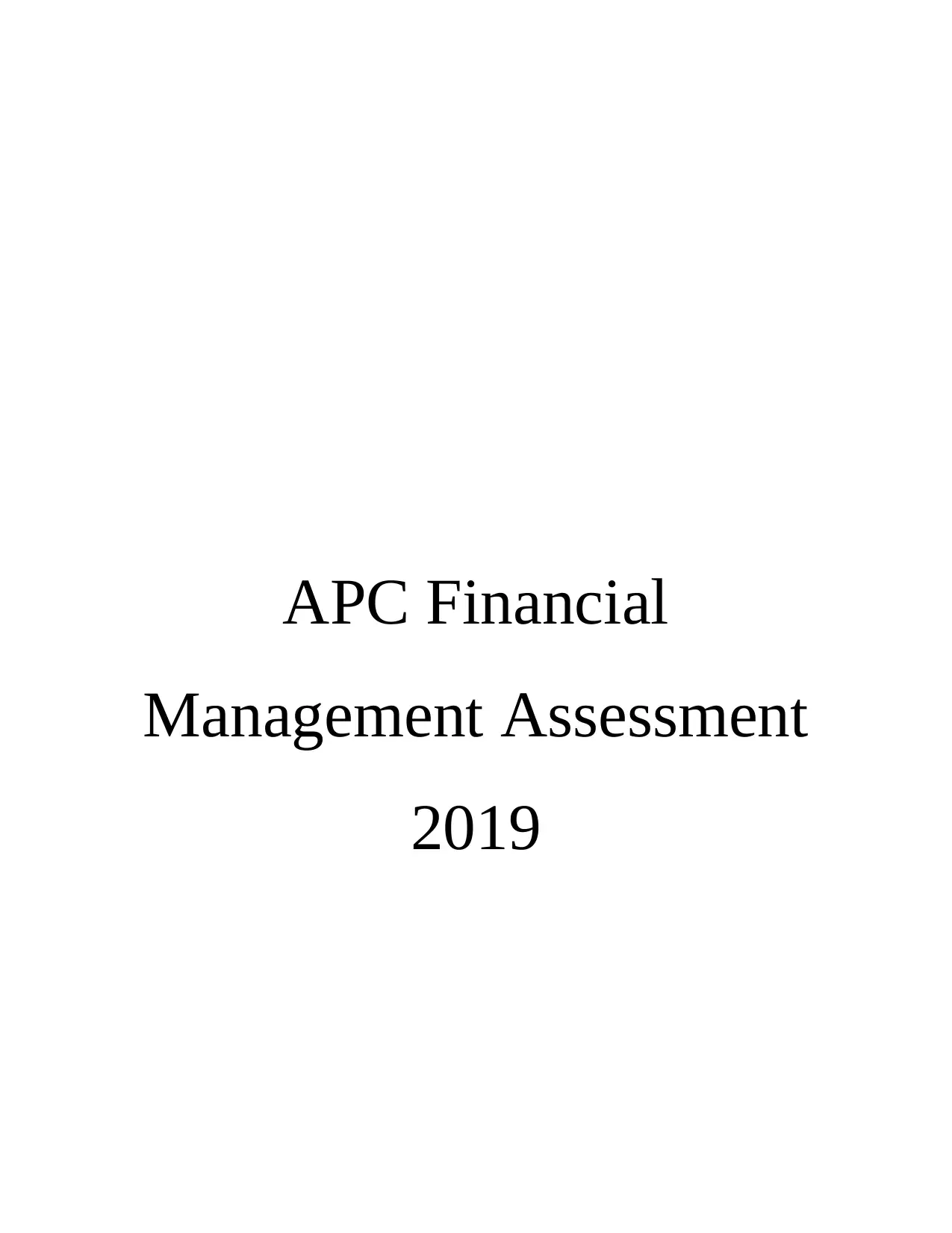
APC Financial
Management Assessment
2019
Management Assessment
2019
Paraphrase This Document
Need a fresh take? Get an instant paraphrase of this document with our AI Paraphraser
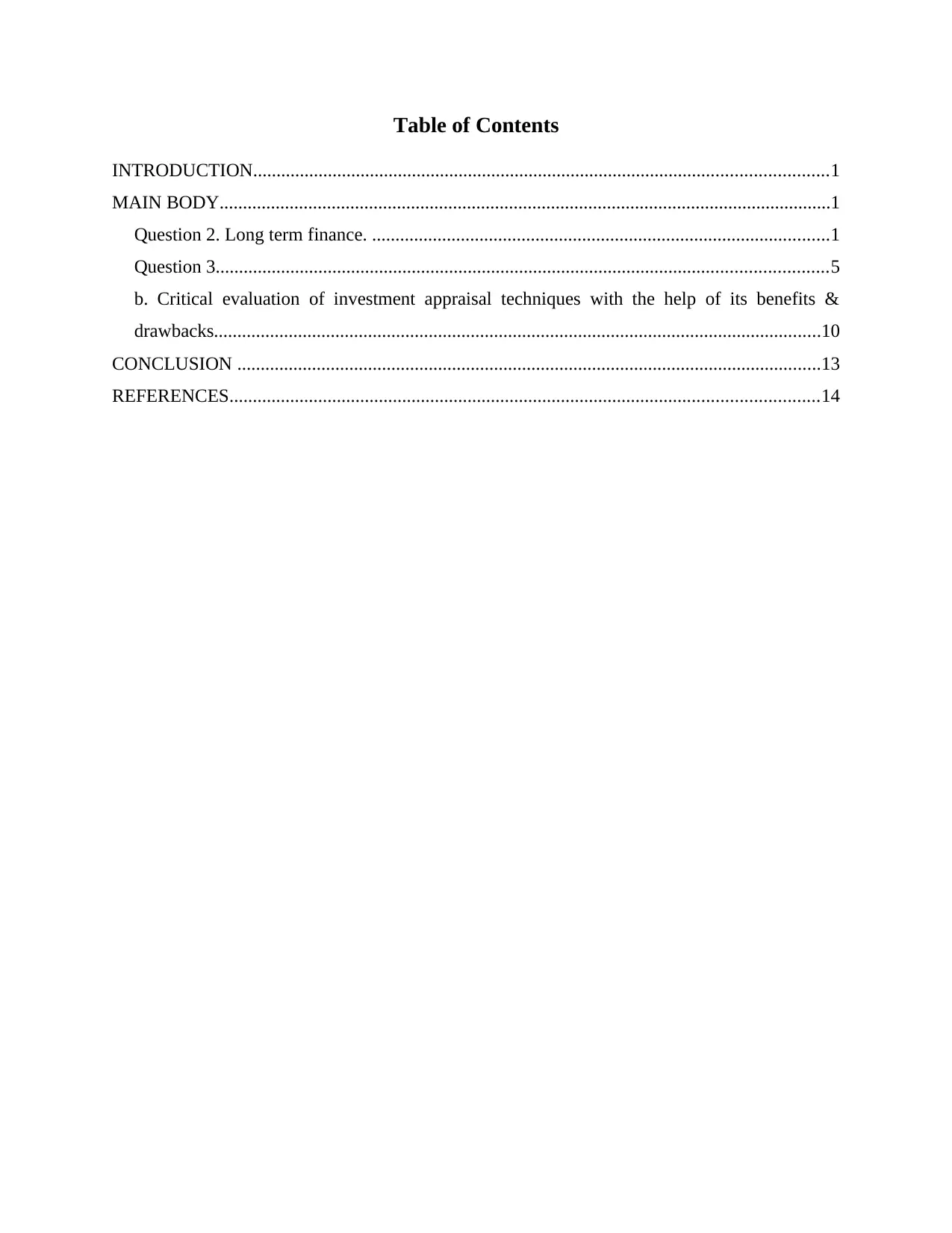
Table of Contents
INTRODUCTION...........................................................................................................................1
MAIN BODY...................................................................................................................................1
Question 2. Long term finance. ..................................................................................................1
Question 3...................................................................................................................................5
b. Critical evaluation of investment appraisal techniques with the help of its benefits &
drawbacks..................................................................................................................................10
CONCLUSION .............................................................................................................................13
REFERENCES..............................................................................................................................14
INTRODUCTION...........................................................................................................................1
MAIN BODY...................................................................................................................................1
Question 2. Long term finance. ..................................................................................................1
Question 3...................................................................................................................................5
b. Critical evaluation of investment appraisal techniques with the help of its benefits &
drawbacks..................................................................................................................................10
CONCLUSION .............................................................................................................................13
REFERENCES..............................................................................................................................14
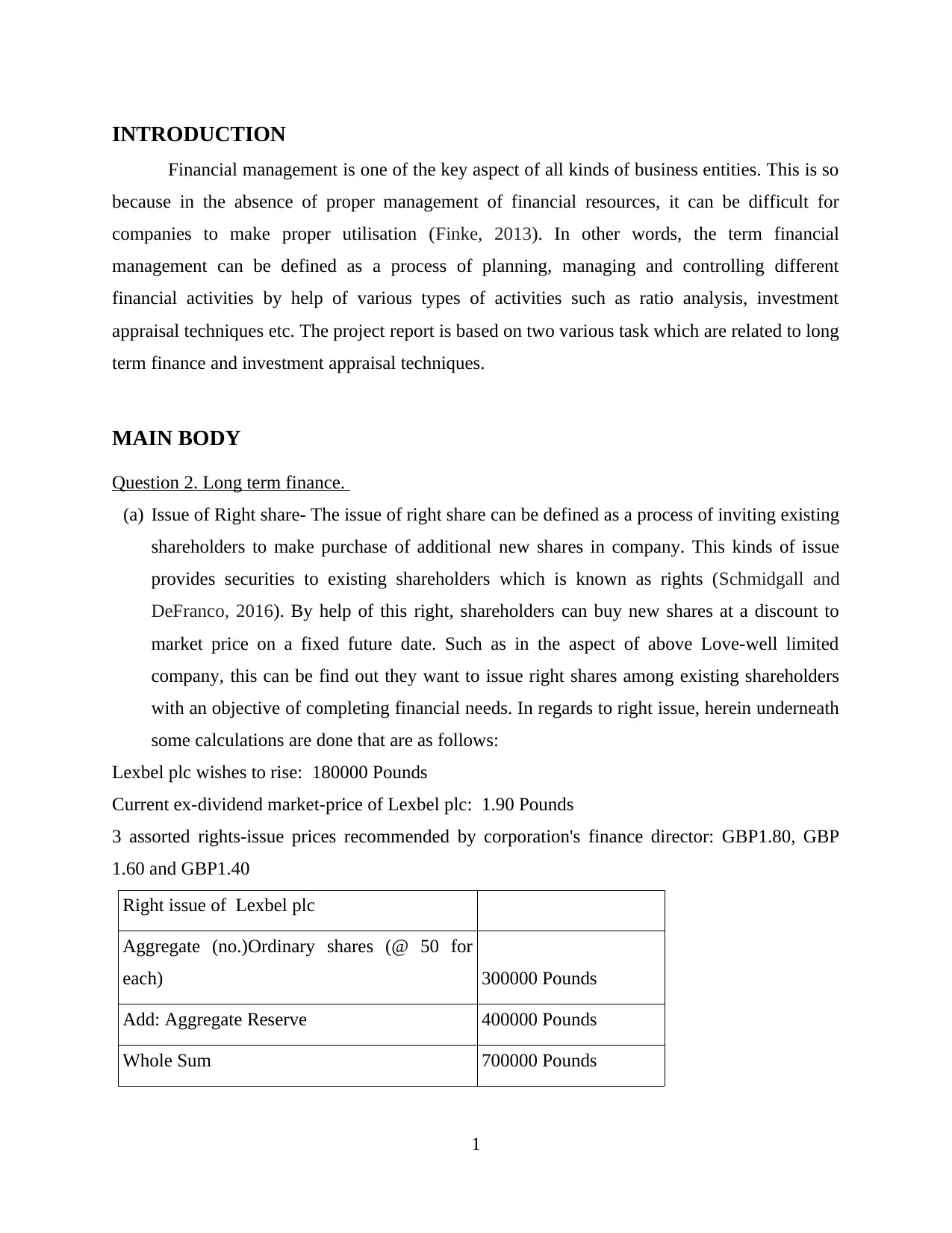
INTRODUCTION
Financial management is one of the key aspect of all kinds of business entities. This is so
because in the absence of proper management of financial resources, it can be difficult for
companies to make proper utilisation (Finke, 2013). In other words, the term financial
management can be defined as a process of planning, managing and controlling different
financial activities by help of various types of activities such as ratio analysis, investment
appraisal techniques etc. The project report is based on two various task which are related to long
term finance and investment appraisal techniques.
MAIN BODY
Question 2. Long term finance.
(a) Issue of Right share- The issue of right share can be defined as a process of inviting existing
shareholders to make purchase of additional new shares in company. This kinds of issue
provides securities to existing shareholders which is known as rights (Schmidgall and
DeFranco, 2016). By help of this right, shareholders can buy new shares at a discount to
market price on a fixed future date. Such as in the aspect of above Love-well limited
company, this can be find out they want to issue right shares among existing shareholders
with an objective of completing financial needs. In regards to right issue, herein underneath
some calculations are done that are as follows:
Lexbel plc wishes to rise: 180000 Pounds
Current ex-dividend market-price of Lexbel plc: 1.90 Pounds
3 assorted rights-issue prices recommended by corporation's finance director: GBP1.80, GBP
1.60 and GBP1.40
Right issue of Lexbel plc
Aggregate (no.)Ordinary shares (@ 50 for
each) 300000 Pounds
Add: Aggregate Reserve 400000 Pounds
Whole Sum 700000 Pounds
1
Financial management is one of the key aspect of all kinds of business entities. This is so
because in the absence of proper management of financial resources, it can be difficult for
companies to make proper utilisation (Finke, 2013). In other words, the term financial
management can be defined as a process of planning, managing and controlling different
financial activities by help of various types of activities such as ratio analysis, investment
appraisal techniques etc. The project report is based on two various task which are related to long
term finance and investment appraisal techniques.
MAIN BODY
Question 2. Long term finance.
(a) Issue of Right share- The issue of right share can be defined as a process of inviting existing
shareholders to make purchase of additional new shares in company. This kinds of issue
provides securities to existing shareholders which is known as rights (Schmidgall and
DeFranco, 2016). By help of this right, shareholders can buy new shares at a discount to
market price on a fixed future date. Such as in the aspect of above Love-well limited
company, this can be find out they want to issue right shares among existing shareholders
with an objective of completing financial needs. In regards to right issue, herein underneath
some calculations are done that are as follows:
Lexbel plc wishes to rise: 180000 Pounds
Current ex-dividend market-price of Lexbel plc: 1.90 Pounds
3 assorted rights-issue prices recommended by corporation's finance director: GBP1.80, GBP
1.60 and GBP1.40
Right issue of Lexbel plc
Aggregate (no.)Ordinary shares (@ 50 for
each) 300000 Pounds
Add: Aggregate Reserve 400000 Pounds
Whole Sum 700000 Pounds
1
⊘ This is a preview!⊘
Do you want full access?
Subscribe today to unlock all pages.

Trusted by 1+ million students worldwide
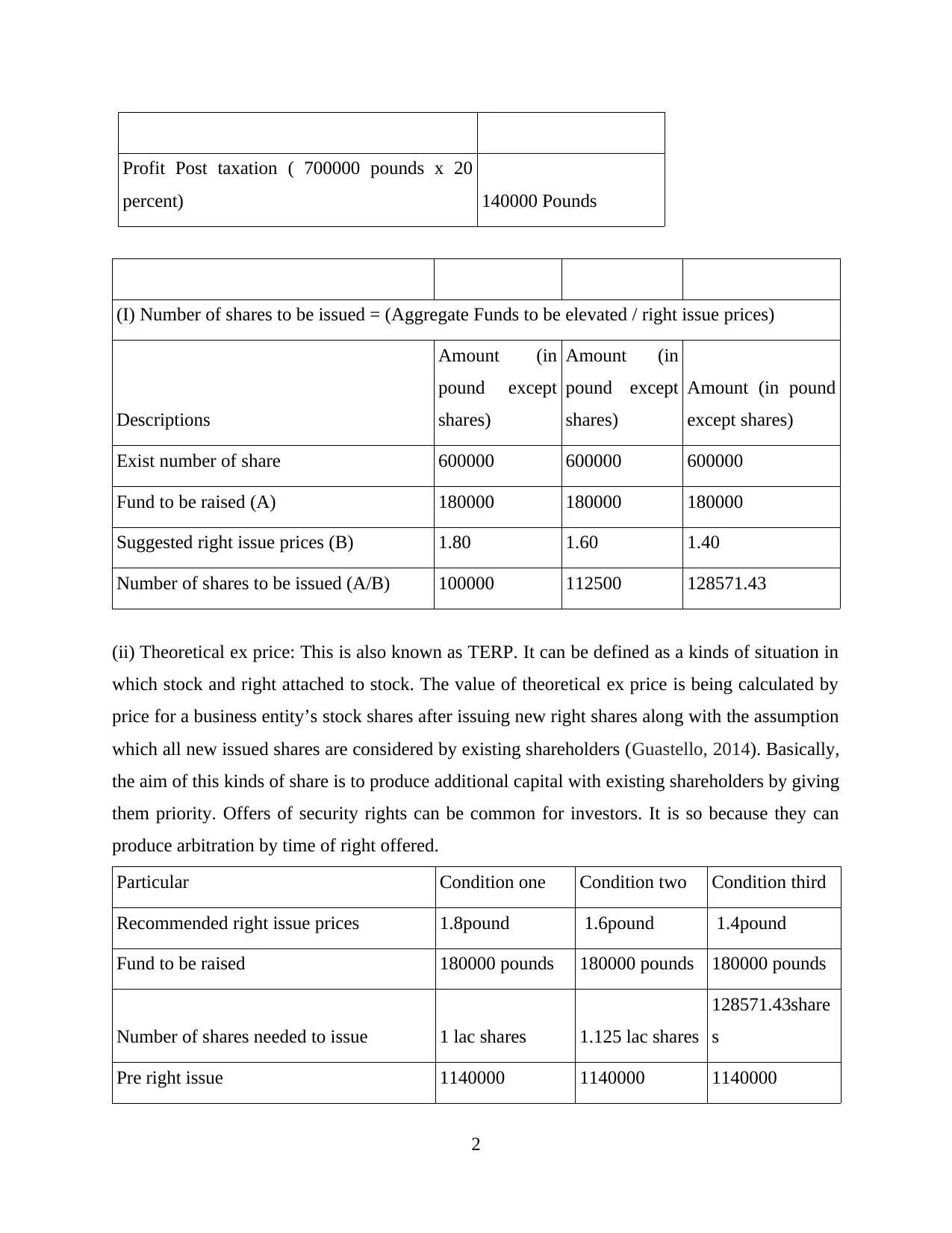
Profit Post taxation ( 700000 pounds x 20
percent) 140000 Pounds
(I) Number of shares to be issued = (Aggregate Funds to be elevated / right issue prices)
Descriptions
Amount (in
pound except
shares)
Amount (in
pound except
shares)
Amount (in pound
except shares)
Exist number of share 600000 600000 600000
Fund to be raised (A) 180000 180000 180000
Suggested right issue prices (B) 1.80 1.60 1.40
Number of shares to be issued (A/B) 100000 112500 128571.43
(ii) Theoretical ex price: This is also known as TERP. It can be defined as a kinds of situation in
which stock and right attached to stock. The value of theoretical ex price is being calculated by
price for a business entity’s stock shares after issuing new right shares along with the assumption
which all new issued shares are considered by existing shareholders (Guastello, 2014). Basically,
the aim of this kinds of share is to produce additional capital with existing shareholders by giving
them priority. Offers of security rights can be common for investors. It is so because they can
produce arbitration by time of right offered.
Particular Condition one Condition two Condition third
Recommended right issue prices 1.8pound 1.6pound 1.4pound
Fund to be raised 180000 pounds 180000 pounds 180000 pounds
Number of shares needed to issue 1 lac shares 1.125 lac shares
128571.43share
s
Pre right issue 1140000 1140000 1140000
2
percent) 140000 Pounds
(I) Number of shares to be issued = (Aggregate Funds to be elevated / right issue prices)
Descriptions
Amount (in
pound except
shares)
Amount (in
pound except
shares)
Amount (in pound
except shares)
Exist number of share 600000 600000 600000
Fund to be raised (A) 180000 180000 180000
Suggested right issue prices (B) 1.80 1.60 1.40
Number of shares to be issued (A/B) 100000 112500 128571.43
(ii) Theoretical ex price: This is also known as TERP. It can be defined as a kinds of situation in
which stock and right attached to stock. The value of theoretical ex price is being calculated by
price for a business entity’s stock shares after issuing new right shares along with the assumption
which all new issued shares are considered by existing shareholders (Guastello, 2014). Basically,
the aim of this kinds of share is to produce additional capital with existing shareholders by giving
them priority. Offers of security rights can be common for investors. It is so because they can
produce arbitration by time of right offered.
Particular Condition one Condition two Condition third
Recommended right issue prices 1.8pound 1.6pound 1.4pound
Fund to be raised 180000 pounds 180000 pounds 180000 pounds
Number of shares needed to issue 1 lac shares 1.125 lac shares
128571.43share
s
Pre right issue 1140000 1140000 1140000
2
Paraphrase This Document
Need a fresh take? Get an instant paraphrase of this document with our AI Paraphraser
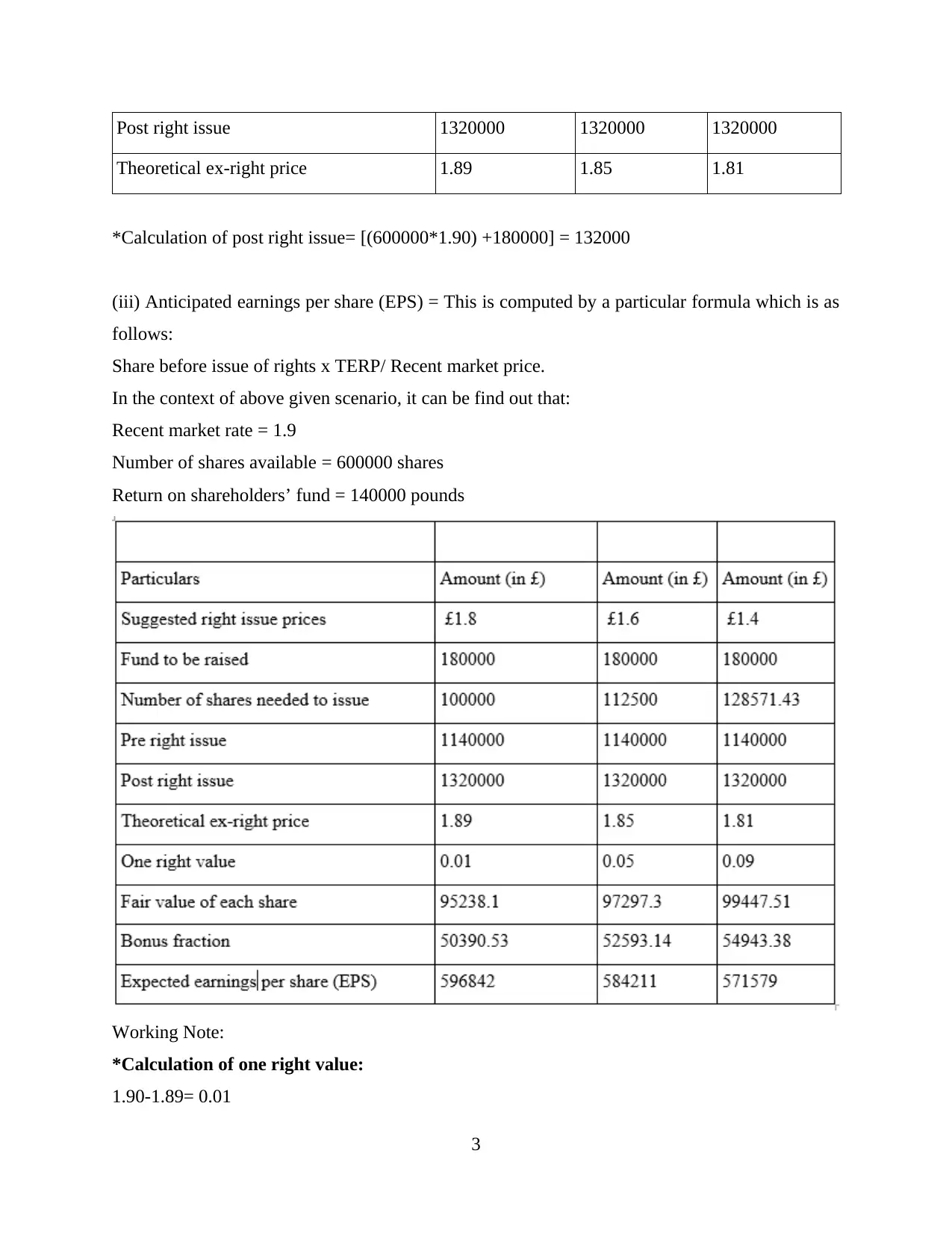
Post right issue 1320000 1320000 1320000
Theoretical ex-right price 1.89 1.85 1.81
*Calculation of post right issue= [(600000*1.90) +180000] = 132000
(iii) Anticipated earnings per share (EPS) = This is computed by a particular formula which is as
follows:
Share before issue of rights x TERP/ Recent market price.
In the context of above given scenario, it can be find out that:
Recent market rate = 1.9
Number of shares available = 600000 shares
Return on shareholders’ fund = 140000 pounds
Working Note:
*Calculation of one right value:
1.90-1.89= 0.01
3
Theoretical ex-right price 1.89 1.85 1.81
*Calculation of post right issue= [(600000*1.90) +180000] = 132000
(iii) Anticipated earnings per share (EPS) = This is computed by a particular formula which is as
follows:
Share before issue of rights x TERP/ Recent market price.
In the context of above given scenario, it can be find out that:
Recent market rate = 1.9
Number of shares available = 600000 shares
Return on shareholders’ fund = 140000 pounds
Working Note:
*Calculation of one right value:
1.90-1.89= 0.01
3
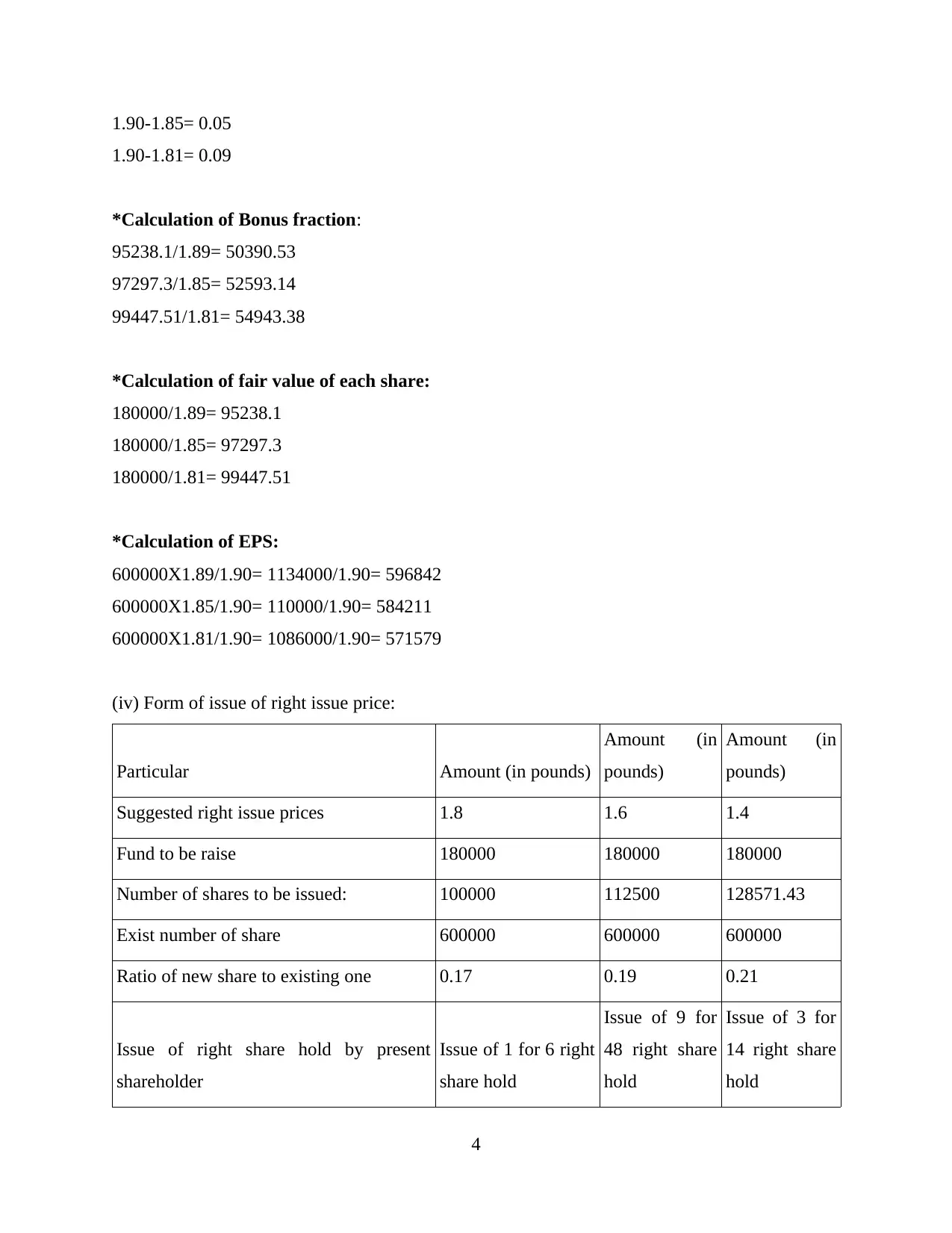
1.90-1.85= 0.05
1.90-1.81= 0.09
*Calculation of Bonus fraction:
95238.1/1.89= 50390.53
97297.3/1.85= 52593.14
99447.51/1.81= 54943.38
*Calculation of fair value of each share:
180000/1.89= 95238.1
180000/1.85= 97297.3
180000/1.81= 99447.51
*Calculation of EPS:
600000X1.89/1.90= 1134000/1.90= 596842
600000X1.85/1.90= 110000/1.90= 584211
600000X1.81/1.90= 1086000/1.90= 571579
(iv) Form of issue of right issue price:
Particular Amount (in pounds)
Amount (in
pounds)
Amount (in
pounds)
Suggested right issue prices 1.8 1.6 1.4
Fund to be raise 180000 180000 180000
Number of shares to be issued: 100000 112500 128571.43
Exist number of share 600000 600000 600000
Ratio of new share to existing one 0.17 0.19 0.21
Issue of right share hold by present
shareholder
Issue of 1 for 6 right
share hold
Issue of 9 for
48 right share
hold
Issue of 3 for
14 right share
hold
4
1.90-1.81= 0.09
*Calculation of Bonus fraction:
95238.1/1.89= 50390.53
97297.3/1.85= 52593.14
99447.51/1.81= 54943.38
*Calculation of fair value of each share:
180000/1.89= 95238.1
180000/1.85= 97297.3
180000/1.81= 99447.51
*Calculation of EPS:
600000X1.89/1.90= 1134000/1.90= 596842
600000X1.85/1.90= 110000/1.90= 584211
600000X1.81/1.90= 1086000/1.90= 571579
(iv) Form of issue of right issue price:
Particular Amount (in pounds)
Amount (in
pounds)
Amount (in
pounds)
Suggested right issue prices 1.8 1.6 1.4
Fund to be raise 180000 180000 180000
Number of shares to be issued: 100000 112500 128571.43
Exist number of share 600000 600000 600000
Ratio of new share to existing one 0.17 0.19 0.21
Issue of right share hold by present
shareholder
Issue of 1 for 6 right
share hold
Issue of 9 for
48 right share
hold
Issue of 3 for
14 right share
hold
4
⊘ This is a preview!⊘
Do you want full access?
Subscribe today to unlock all pages.

Trusted by 1+ million students worldwide
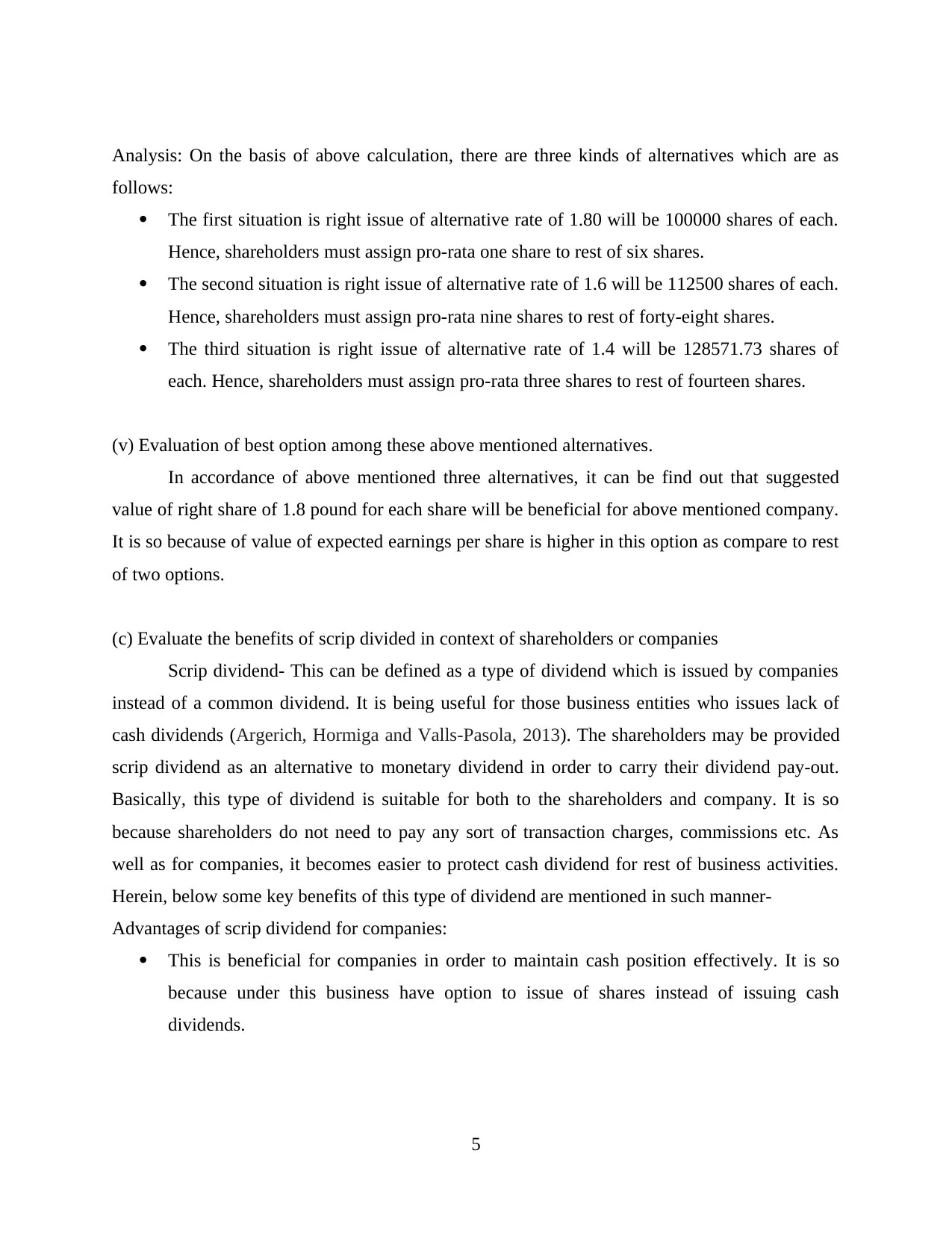
Analysis: On the basis of above calculation, there are three kinds of alternatives which are as
follows:
The first situation is right issue of alternative rate of 1.80 will be 100000 shares of each.
Hence, shareholders must assign pro-rata one share to rest of six shares.
The second situation is right issue of alternative rate of 1.6 will be 112500 shares of each.
Hence, shareholders must assign pro-rata nine shares to rest of forty-eight shares.
The third situation is right issue of alternative rate of 1.4 will be 128571.73 shares of
each. Hence, shareholders must assign pro-rata three shares to rest of fourteen shares.
(v) Evaluation of best option among these above mentioned alternatives.
In accordance of above mentioned three alternatives, it can be find out that suggested
value of right share of 1.8 pound for each share will be beneficial for above mentioned company.
It is so because of value of expected earnings per share is higher in this option as compare to rest
of two options.
(c) Evaluate the benefits of scrip divided in context of shareholders or companies
Scrip dividend- This can be defined as a type of dividend which is issued by companies
instead of a common dividend. It is being useful for those business entities who issues lack of
cash dividends (Argerich, Hormiga and Valls-Pasola, 2013). The shareholders may be provided
scrip dividend as an alternative to monetary dividend in order to carry their dividend pay-out.
Basically, this type of dividend is suitable for both to the shareholders and company. It is so
because shareholders do not need to pay any sort of transaction charges, commissions etc. As
well as for companies, it becomes easier to protect cash dividend for rest of business activities.
Herein, below some key benefits of this type of dividend are mentioned in such manner-
Advantages of scrip dividend for companies:
This is beneficial for companies in order to maintain cash position effectively. It is so
because under this business have option to issue of shares instead of issuing cash
dividends.
5
follows:
The first situation is right issue of alternative rate of 1.80 will be 100000 shares of each.
Hence, shareholders must assign pro-rata one share to rest of six shares.
The second situation is right issue of alternative rate of 1.6 will be 112500 shares of each.
Hence, shareholders must assign pro-rata nine shares to rest of forty-eight shares.
The third situation is right issue of alternative rate of 1.4 will be 128571.73 shares of
each. Hence, shareholders must assign pro-rata three shares to rest of fourteen shares.
(v) Evaluation of best option among these above mentioned alternatives.
In accordance of above mentioned three alternatives, it can be find out that suggested
value of right share of 1.8 pound for each share will be beneficial for above mentioned company.
It is so because of value of expected earnings per share is higher in this option as compare to rest
of two options.
(c) Evaluate the benefits of scrip divided in context of shareholders or companies
Scrip dividend- This can be defined as a type of dividend which is issued by companies
instead of a common dividend. It is being useful for those business entities who issues lack of
cash dividends (Argerich, Hormiga and Valls-Pasola, 2013). The shareholders may be provided
scrip dividend as an alternative to monetary dividend in order to carry their dividend pay-out.
Basically, this type of dividend is suitable for both to the shareholders and company. It is so
because shareholders do not need to pay any sort of transaction charges, commissions etc. As
well as for companies, it becomes easier to protect cash dividend for rest of business activities.
Herein, below some key benefits of this type of dividend are mentioned in such manner-
Advantages of scrip dividend for companies:
This is beneficial for companies in order to maintain cash position effectively. It is so
because under this business have option to issue of shares instead of issuing cash
dividends.
5
Paraphrase This Document
Need a fresh take? Get an instant paraphrase of this document with our AI Paraphraser
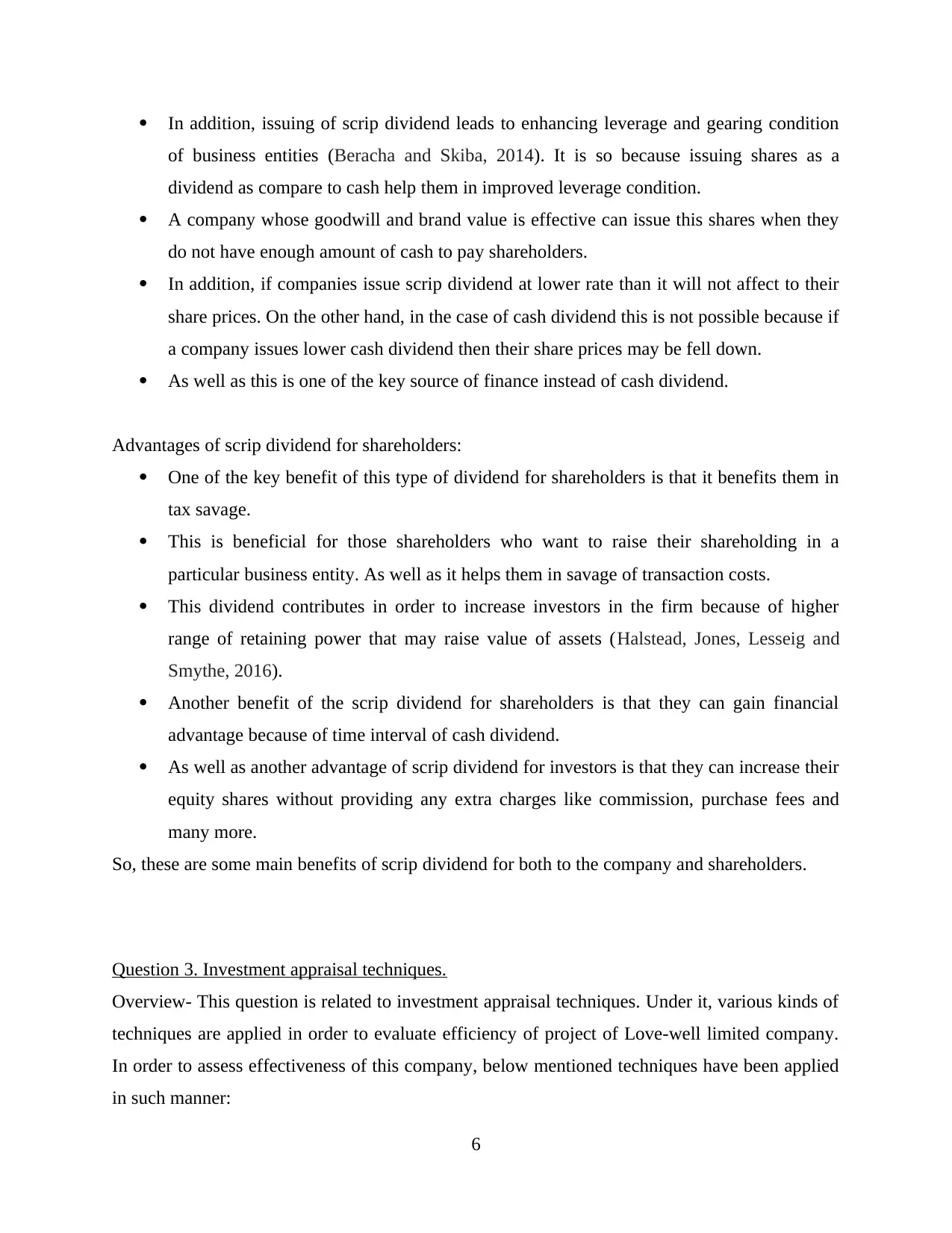
In addition, issuing of scrip dividend leads to enhancing leverage and gearing condition
of business entities (Beracha and Skiba, 2014). It is so because issuing shares as a
dividend as compare to cash help them in improved leverage condition.
A company whose goodwill and brand value is effective can issue this shares when they
do not have enough amount of cash to pay shareholders.
In addition, if companies issue scrip dividend at lower rate than it will not affect to their
share prices. On the other hand, in the case of cash dividend this is not possible because if
a company issues lower cash dividend then their share prices may be fell down.
As well as this is one of the key source of finance instead of cash dividend.
Advantages of scrip dividend for shareholders:
One of the key benefit of this type of dividend for shareholders is that it benefits them in
tax savage.
This is beneficial for those shareholders who want to raise their shareholding in a
particular business entity. As well as it helps them in savage of transaction costs.
This dividend contributes in order to increase investors in the firm because of higher
range of retaining power that may raise value of assets (Halstead, Jones, Lesseig and
Smythe, 2016).
Another benefit of the scrip dividend for shareholders is that they can gain financial
advantage because of time interval of cash dividend.
As well as another advantage of scrip dividend for investors is that they can increase their
equity shares without providing any extra charges like commission, purchase fees and
many more.
So, these are some main benefits of scrip dividend for both to the company and shareholders.
Question 3. Investment appraisal techniques.
Overview- This question is related to investment appraisal techniques. Under it, various kinds of
techniques are applied in order to evaluate efficiency of project of Love-well limited company.
In order to assess effectiveness of this company, below mentioned techniques have been applied
in such manner:
6
of business entities (Beracha and Skiba, 2014). It is so because issuing shares as a
dividend as compare to cash help them in improved leverage condition.
A company whose goodwill and brand value is effective can issue this shares when they
do not have enough amount of cash to pay shareholders.
In addition, if companies issue scrip dividend at lower rate than it will not affect to their
share prices. On the other hand, in the case of cash dividend this is not possible because if
a company issues lower cash dividend then their share prices may be fell down.
As well as this is one of the key source of finance instead of cash dividend.
Advantages of scrip dividend for shareholders:
One of the key benefit of this type of dividend for shareholders is that it benefits them in
tax savage.
This is beneficial for those shareholders who want to raise their shareholding in a
particular business entity. As well as it helps them in savage of transaction costs.
This dividend contributes in order to increase investors in the firm because of higher
range of retaining power that may raise value of assets (Halstead, Jones, Lesseig and
Smythe, 2016).
Another benefit of the scrip dividend for shareholders is that they can gain financial
advantage because of time interval of cash dividend.
As well as another advantage of scrip dividend for investors is that they can increase their
equity shares without providing any extra charges like commission, purchase fees and
many more.
So, these are some main benefits of scrip dividend for both to the company and shareholders.
Question 3. Investment appraisal techniques.
Overview- This question is related to investment appraisal techniques. Under it, various kinds of
techniques are applied in order to evaluate efficiency of project of Love-well limited company.
In order to assess effectiveness of this company, below mentioned techniques have been applied
in such manner:
6
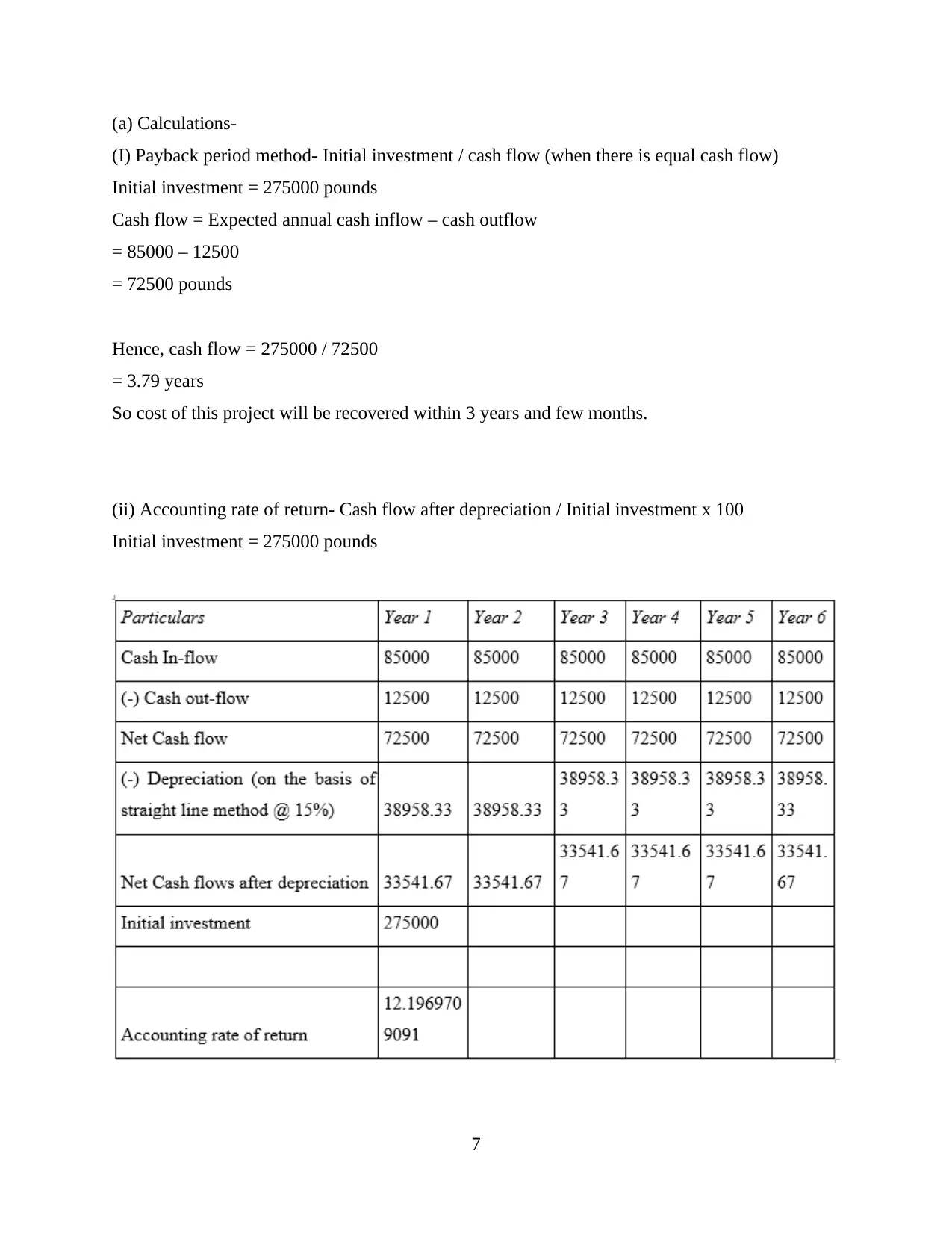
(a) Calculations-
(I) Payback period method- Initial investment / cash flow (when there is equal cash flow)
Initial investment = 275000 pounds
Cash flow = Expected annual cash inflow – cash outflow
= 85000 – 12500
= 72500 pounds
Hence, cash flow = 275000 / 72500
= 3.79 years
So cost of this project will be recovered within 3 years and few months.
(ii) Accounting rate of return- Cash flow after depreciation / Initial investment x 100
Initial investment = 275000 pounds
7
(I) Payback period method- Initial investment / cash flow (when there is equal cash flow)
Initial investment = 275000 pounds
Cash flow = Expected annual cash inflow – cash outflow
= 85000 – 12500
= 72500 pounds
Hence, cash flow = 275000 / 72500
= 3.79 years
So cost of this project will be recovered within 3 years and few months.
(ii) Accounting rate of return- Cash flow after depreciation / Initial investment x 100
Initial investment = 275000 pounds
7
⊘ This is a preview!⊘
Do you want full access?
Subscribe today to unlock all pages.

Trusted by 1+ million students worldwide
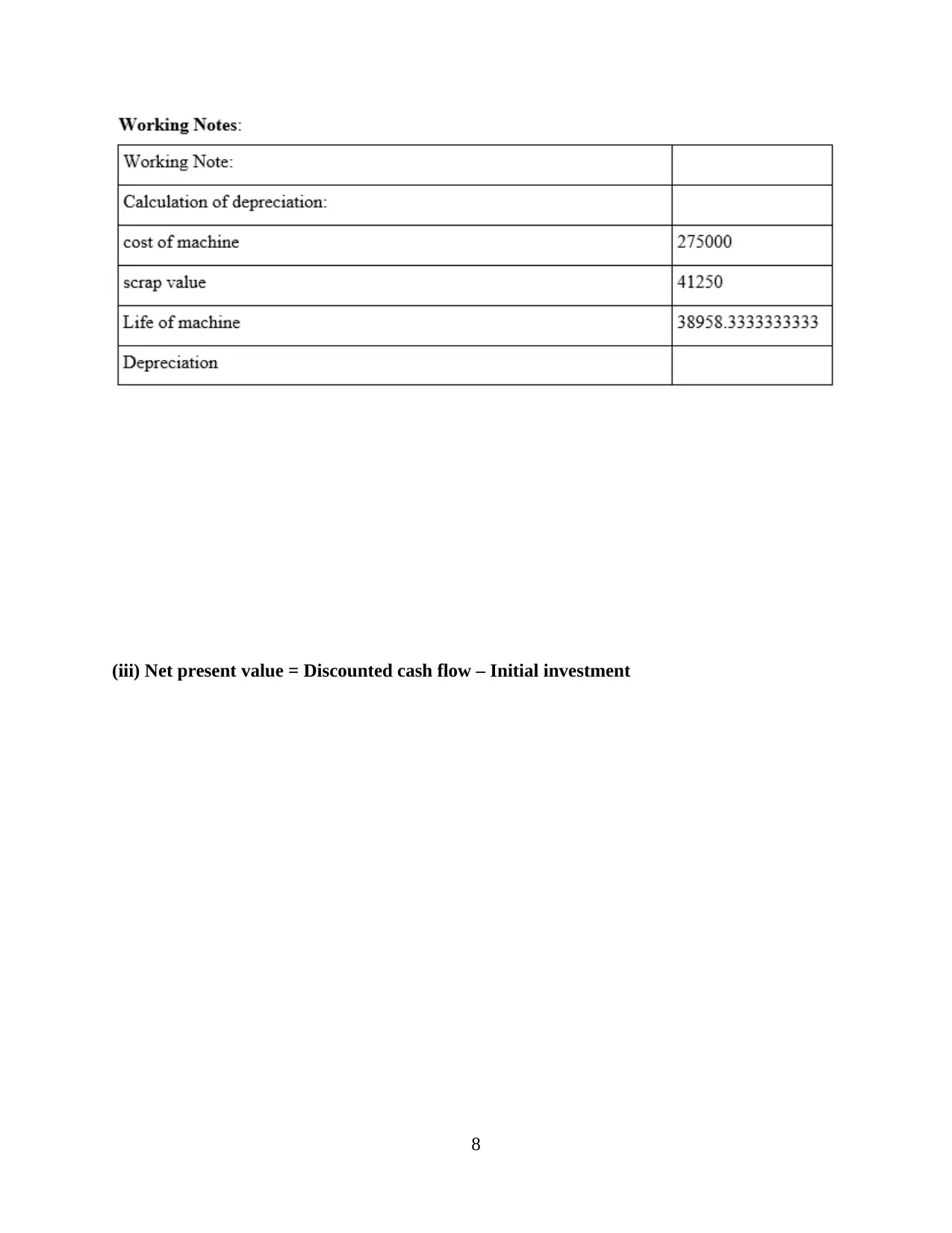
(iii) Net present value = Discounted cash flow – Initial investment
8
8
Paraphrase This Document
Need a fresh take? Get an instant paraphrase of this document with our AI Paraphraser
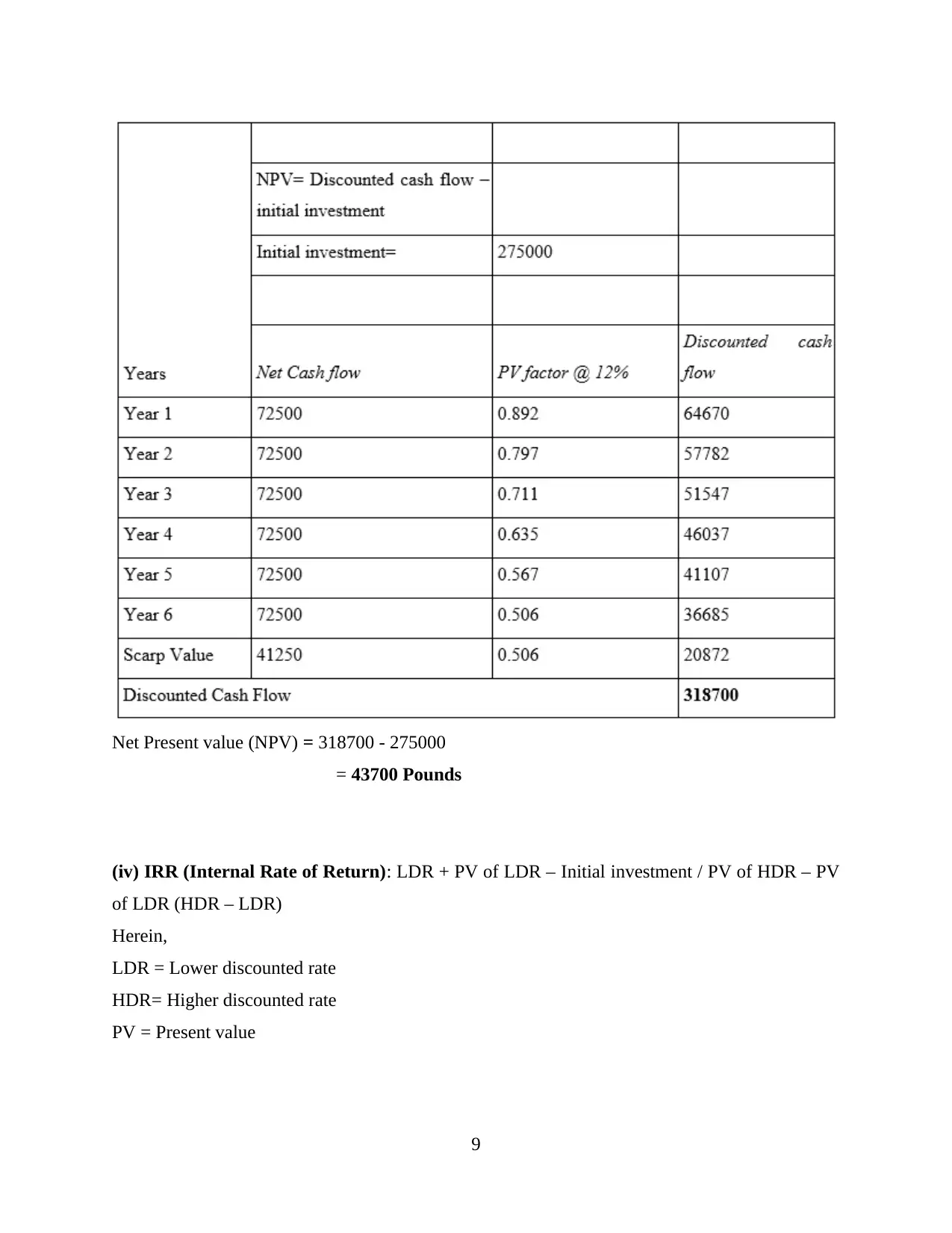
Net Present value (NPV) = 318700 - 275000
= 43700 Pounds
(iv) IRR (Internal Rate of Return): LDR + PV of LDR – Initial investment / PV of HDR – PV
of LDR (HDR – LDR)
Herein,
LDR = Lower discounted rate
HDR= Higher discounted rate
PV = Present value
9
= 43700 Pounds
(iv) IRR (Internal Rate of Return): LDR + PV of LDR – Initial investment / PV of HDR – PV
of LDR (HDR – LDR)
Herein,
LDR = Lower discounted rate
HDR= Higher discounted rate
PV = Present value
9
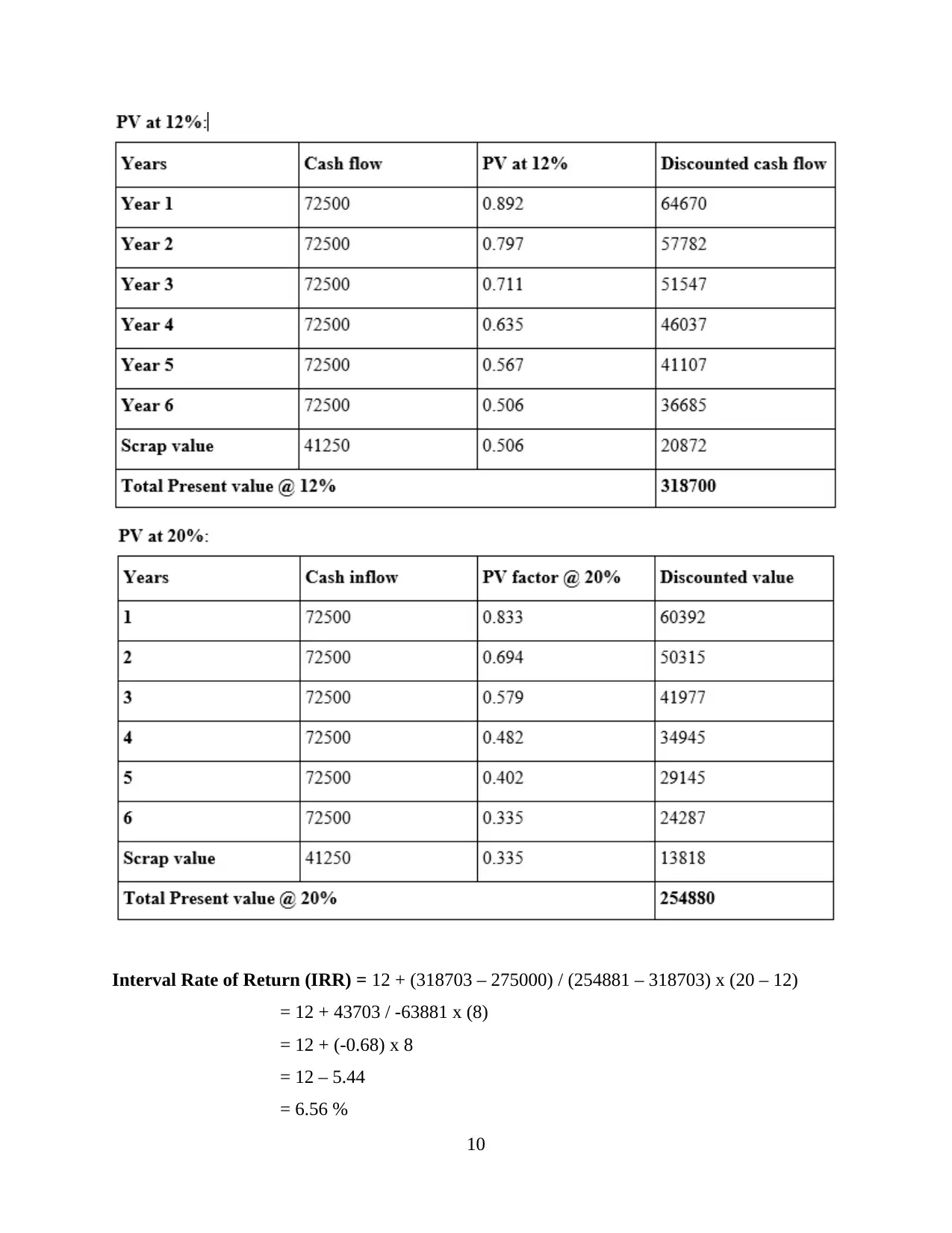
Interval Rate of Return (IRR) = 12 + (318703 – 275000) / (254881 – 318703) x (20 – 12)
= 12 + 43703 / -63881 x (8)
= 12 + (-0.68) x 8
= 12 – 5.44
= 6.56 %
10
= 12 + 43703 / -63881 x (8)
= 12 + (-0.68) x 8
= 12 – 5.44
= 6.56 %
10
⊘ This is a preview!⊘
Do you want full access?
Subscribe today to unlock all pages.

Trusted by 1+ million students worldwide
1 out of 17
Related Documents
Your All-in-One AI-Powered Toolkit for Academic Success.
+13062052269
info@desklib.com
Available 24*7 on WhatsApp / Email
![[object Object]](/_next/static/media/star-bottom.7253800d.svg)
Unlock your academic potential
Copyright © 2020–2025 A2Z Services. All Rights Reserved. Developed and managed by ZUCOL.





